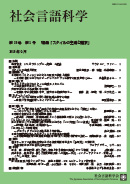Volume 9, Issue 1
Displaying 1-7 of 7 articles from this issue
- |<
- <
- 1
- >
- >|
-
Article type: Article
2006Volume 9Issue 1 Pages 1-3
Published: September 30, 2006
Released on J-STAGE: April 30, 2017
Download PDF (316K) -
Article type: Article
2006Volume 9Issue 1 Pages 4-15
Published: September 30, 2006
Released on J-STAGE: April 30, 2017
Download PDF (1373K) -
Article type: Article
2006Volume 9Issue 1 Pages 16-26
Published: September 30, 2006
Released on J-STAGE: April 30, 2017
Download PDF (1242K) -
Article type: Article
2006Volume 9Issue 1 Pages 27-36
Published: September 30, 2006
Released on J-STAGE: April 30, 2017
Download PDF (1053K) -
Article type: Article
2006Volume 9Issue 1 Pages 37-47
Published: September 30, 2006
Released on J-STAGE: April 30, 2017
Download PDF (1215K) -
Article type: Article
2006Volume 9Issue 1 Pages 48-58
Published: September 30, 2006
Released on J-STAGE: April 30, 2017
Download PDF (1164K) -
Article type: Article
2006Volume 9Issue 1 Pages 59-66
Published: September 30, 2006
Released on J-STAGE: April 30, 2017
Download PDF (890K)
- |<
- <
- 1
- >
- >|
